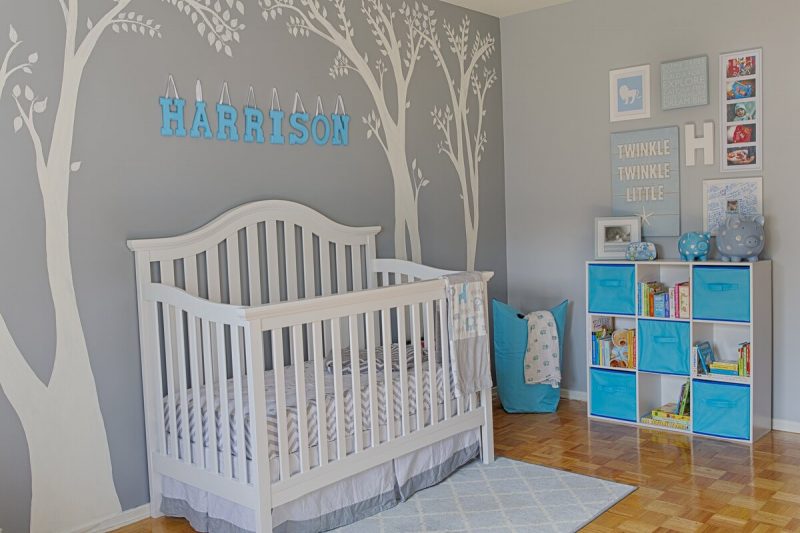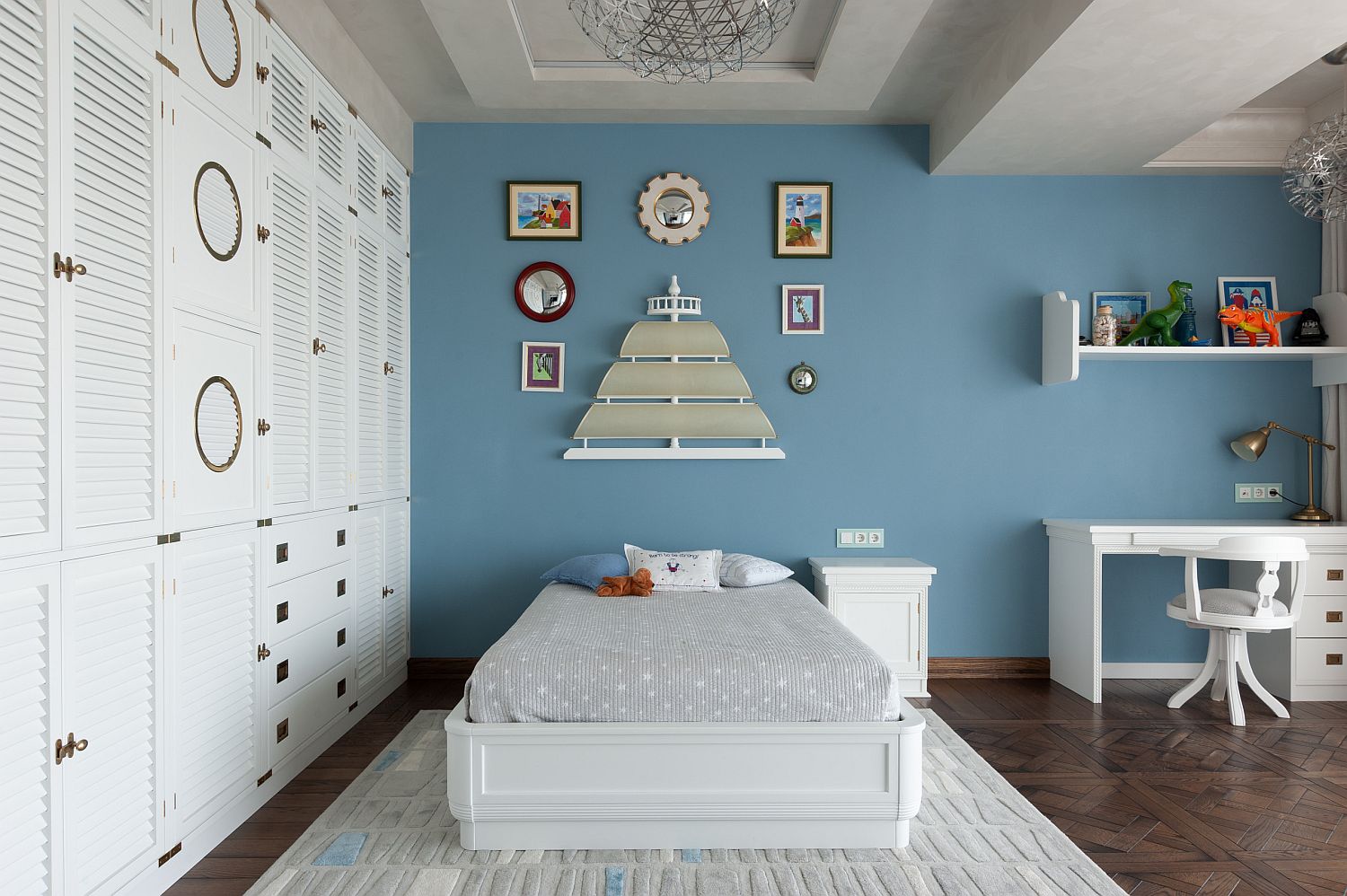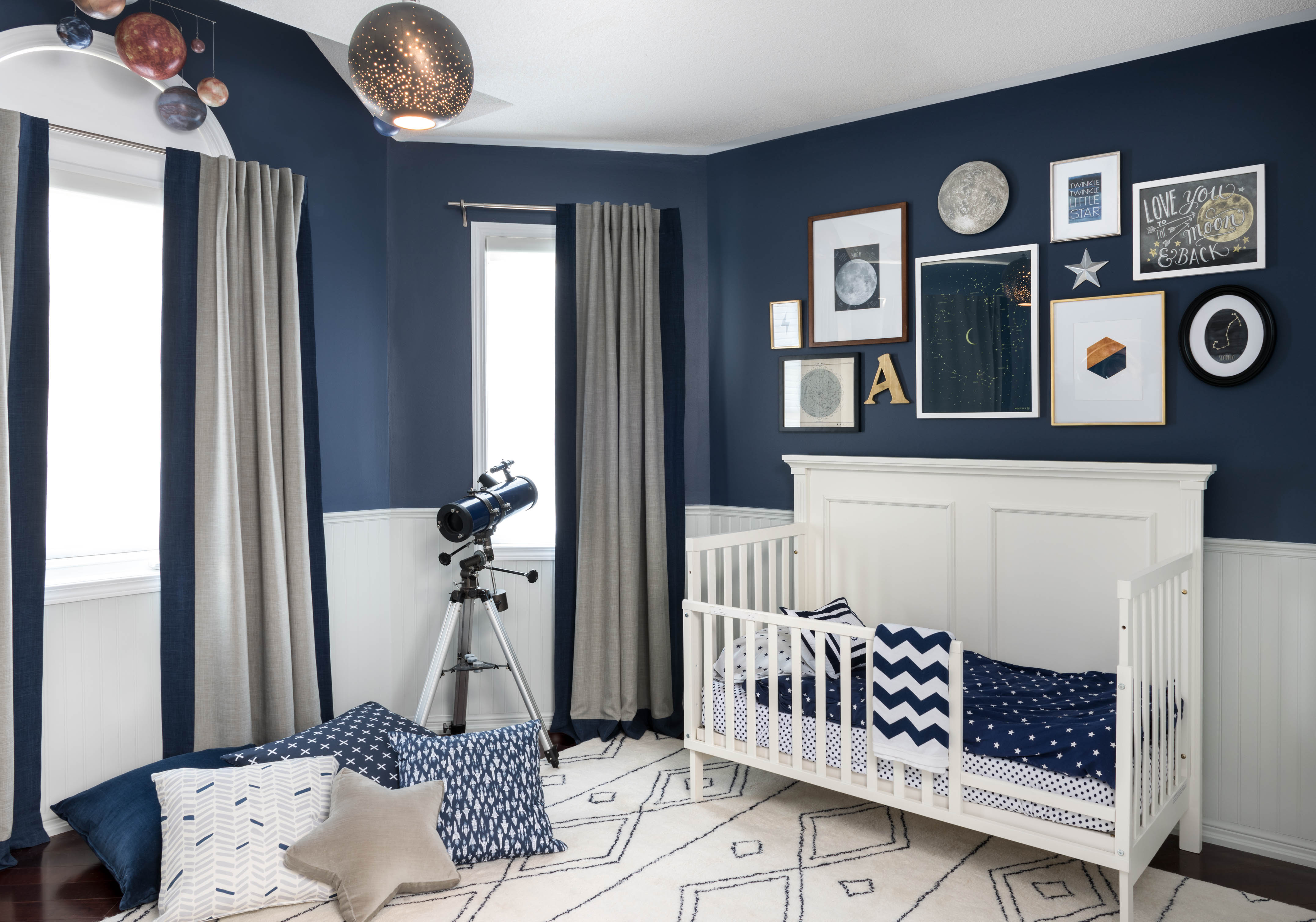Design Inspiration and Color Schemes: Blue And Grey Childrens Bedroom

A blue and grey children’s bedroom offers a serene and calming atmosphere, perfect for promoting restful sleep and encouraging creativity. These colors, often associated with the sky and clouds, evoke a sense of peace and tranquility, creating a soothing environment for children to relax and unwind.
Color Psychology
Blue and grey are versatile colors that can be used to create a wide range of moods and styles. Blue, a cool color, is often associated with calmness, peace, and tranquility. It can also stimulate creativity and encourage focus. Grey, a neutral color, is known for its elegance and sophistication. It can create a sense of calm and serenity, and it can also be used to add a touch of sophistication to a space.
Color Palettes for Different Age Groups
- For babies and toddlers, a light blue and grey color scheme with pops of yellow or green can create a cheerful and playful environment. Consider using a soft, pastel blue for the walls and a light grey for furniture and accents. Add pops of color with yellow or green toys, bedding, or artwork.
- For older children, a bolder blue and grey color scheme with pops of red or orange can create a more sophisticated and energetic environment. Consider using a darker blue for the walls and a medium grey for furniture and accents. Add pops of color with red or orange throw pillows, curtains, or artwork.
- For teenagers, a dark blue and grey color scheme with pops of metallic accents can create a modern and edgy environment. Consider using a deep navy blue for the walls and a charcoal grey for furniture and accents. Add pops of color with gold or silver accents on bedding, lamps, or artwork.
Incorporating Accent Colors
Accent colors can add vibrancy and personality to a blue and grey bedroom. They can be used in a variety of ways, such as through bedding, curtains, rugs, artwork, or accessories.
- For a playful and energetic vibe, consider using bright colors like yellow, orange, or green.
- For a more sophisticated and calming look, consider using muted colors like pink, lavender, or teal.
- For a modern and edgy feel, consider using metallic accents like gold, silver, or copper.
Patterns and Textures
Patterns and textures can add visual interest and depth to a blue and grey bedroom.
- Geometric patterns, such as stripes or polka dots, can add a playful and modern touch.
- Floral patterns can add a touch of whimsy and femininity.
- Textured fabrics, such as velvet, chenille, or faux fur, can add warmth and comfort to the space.
Mood Board
Imagine a bedroom with walls painted in a soft, calming blue. The floor is covered in a plush grey carpet, adding a touch of warmth and comfort. A white dresser with sleek, modern lines sits against one wall, topped with a lamp featuring a geometric shade. The bed is dressed in crisp white linens, accented with throw pillows in a vibrant turquoise. A playful, abstract painting in shades of blue and grey hangs above the bed, adding a touch of whimsy. A fluffy, grey rug sits in front of the bed, adding a cozy feel. The windows are draped with light grey curtains, filtering the sunlight and creating a serene atmosphere. This is just one example of how a blue and grey bedroom can be transformed into a haven of peace and tranquility for a child.
Furniture and Decor

A blue and grey children’s bedroom can be a haven of tranquility and playful energy. The right furniture and decor can transform this space into a haven for rest, play, and creativity.
Essential Furniture Pieces, Blue and grey childrens bedroom
A blue and grey bedroom should include furniture that balances functionality and style. Here are some essential pieces:
- Bed: The bed is the focal point of the room. Choose a comfortable bed frame with a mattress that provides adequate support. A headboard can add visual interest and create a cozy atmosphere.
- Storage Solutions: Ample storage is crucial for keeping the room organized. This can include a dresser, nightstand, shelves, or a wardrobe.
- Desk or Play Table: Depending on the child’s age, a desk or play table provides a dedicated space for studying, crafting, or playing.
- Chair: A comfortable chair is essential for reading, relaxing, or simply enjoying the room.
- Rug: A rug adds warmth, texture, and visual interest to the floor. It can also define different areas within the room.
Choosing Age-Appropriate Furniture
When selecting furniture, consider the child’s age and developmental stage.
- Toddlers and Preschoolers: Choose furniture with rounded edges and sturdy construction. Opt for low-lying furniture that is easy for little ones to access and climb on.
- School-Aged Children: Furniture should be more functional and adaptable. Choose desks with adjustable heights, storage solutions with compartments, and chairs with good back support.
- Teenagers: Furniture should reflect their growing independence and evolving style. Choose pieces that are stylish, functional, and allow for personalization.
Playful and Functional Decor
Decor elements can add personality and fun to the room.
- Wall Art: Incorporate artwork that reflects the child’s interests. This can include posters, paintings, framed prints, or even DIY creations.
- Textiles: Use colorful and patterned textiles to add visual interest. This can include throw pillows, blankets, and curtains.
- Storage Bins: Storage bins can be used to organize toys, books, or clothes. Choose bins with fun designs or labels to make storage more engaging.
- Lighting: Lighting can set the mood and enhance the overall ambiance of the room. Consider using a combination of overhead lighting, lamps, and string lights.
Lighting Options
Proper lighting is essential for a well-designed bedroom.
- Overhead Lighting: A ceiling fixture provides general illumination for the room. Choose a fixture that is age-appropriate and provides adequate light.
- Lamps: Table lamps or floor lamps offer focused light for reading, studying, or playing.
- String Lights: String lights can add a whimsical touch and create a cozy atmosphere.
Essential Accessories
Accessories can complete the look and feel of the room.
- Rugs: A rug adds warmth, texture, and visual interest to the floor. Choose a rug in a color that complements the blue and grey color scheme.
- Curtains: Curtains can provide privacy, block out light, and add a decorative touch. Choose curtains in a color or pattern that complements the overall design.
- Bedding: Choose bedding in a color or pattern that complements the blue and grey color scheme. Consider using a duvet cover with a playful design or a patterned throw blanket.
Creating a Functional and Fun Space

A blue and gray children’s bedroom can be a haven for play and relaxation, providing a comfortable and stimulating environment for your little one. By incorporating educational elements and stimulating activities, you can create a space that encourages learning and growth while ensuring safety and accessibility.
Maximizing Space and Creating a Clutter-Free Environment
Maintaining a clutter-free environment in a children’s bedroom is essential for creating a sense of calm and promoting organization. Maximizing space can be achieved through clever storage solutions and multi-functional furniture.
- Utilize vertical space: Shelves, cubbies, and wall-mounted organizers are excellent for storing toys, books, and clothes, freeing up floor space for play and movement.
- Invest in multi-functional furniture: A storage bed with drawers or a play table with built-in storage compartments can maximize space and provide a dedicated area for play and organization.
- Use baskets and bins: Baskets and bins are a great way to store toys and keep them organized. Label them with pictures or words to make it easy for your child to put away their belongings.
- Regular decluttering: Encourage your child to participate in regular decluttering sessions. This helps them learn the importance of letting go of items they no longer use or need.
Incorporating Educational Elements and Stimulating Activities
A children’s bedroom should be a space that encourages learning and exploration. By incorporating educational elements and stimulating activities, you can create an environment that fosters creativity, imagination, and cognitive development.
- Interactive wall art: Wall decals, chalkboard paint, or magnetic boards can be used to create interactive surfaces that encourage drawing, writing, and problem-solving.
- Reading nook: A cozy reading nook with comfortable seating and a selection of age-appropriate books can inspire a love of reading and storytelling.
- Play area: A designated play area with toys, games, and building blocks can encourage imaginative play and fine motor skills development.
- Educational toys: Choose toys that promote learning and development, such as puzzles, building blocks, and manipulative toys.
Safety and Accessibility in a Children’s Bedroom
Safety and accessibility are paramount in a children’s bedroom. Consider the following safety tips to create a secure and comfortable environment for your child.
- Secure furniture: Make sure all furniture is stable and secure to prevent tipping over. Use furniture anchors to secure heavy furniture to the wall.
- Install window guards: Install window guards to prevent falls from windows, especially if your child’s bedroom is on a higher floor.
- Use non-toxic materials: Choose furniture, toys, and decor made from non-toxic materials to minimize exposure to harmful chemicals.
- Provide adequate lighting: Ensure the room has sufficient lighting, both natural and artificial, to prevent accidents and promote safety.
Choosing Age-Appropriate Toys and Games
Selecting age-appropriate toys and games is crucial for fostering a child’s development and ensuring their safety. Here are some guidelines for choosing toys that are both fun and beneficial:
- Consider developmental stages: Choose toys that are appropriate for your child’s age and developmental stage. For example, toddlers need toys that promote gross motor skills, while preschoolers benefit from toys that encourage language development and problem-solving.
- Look for educational value: Choose toys that offer educational value, such as puzzles, building blocks, and manipulative toys.
- Encourage creativity and imagination: Select toys that encourage creativity and imaginative play, such as dolls, action figures, and play sets.
- Prioritize safety: Always choose toys that meet safety standards and are free from small parts that could pose a choking hazard.
Blue and grey childrens bedroom – A blue and grey children’s bedroom can be calming and serene, but sometimes you need a little more pizzazz! If you’re feeling adventurous, why not take inspiration from a hot pink and blue bedroom and add a splash of vibrant color to your child’s space?
Just remember, a little goes a long way – you don’t want to turn their room into a disco ball! After all, even the most energetic kid needs a place to rest their head at the end of the day.
A blue and grey children’s bedroom is a classic choice, but let’s be honest, sometimes you need a little extra storage for all those toys! Adding a white corner drawers bedroom is a great way to do just that, and it can even add a touch of modern chic to the space.
Just make sure the drawers are deep enough to hold all those stuffed animals, because even the coolest kids have their sentimental side!
